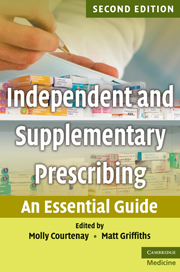Book contents
- Frontmatter
- Contents
- List of contributors
- Foreword to the second edition
- Preface to the second edition
- 1 Non-medical prescribing: an overview
- 2 Non-medical prescribing in a multidisciplinary team context
- 3 Consultation skills and decision making
- 4 Legal aspects of independent and supplementary prescribing
- 5 Ethical issues in independent and supplementary prescribing
- 6 Psychology and sociology of prescribing
- 7 Applied pharmacology
- 8 Monitoring skills
- 9 Promoting concordance in prescribing interactions
- 10 Evidence-based prescribing
- 11 Extended/supplementary prescribing: a public health perspective
- 12 Calculation skills
- 13 Prescribing in practice: how it works
- 14 Minimising the risk of prescribing error
- Index
- References
11 - Extended/supplementary prescribing: a public health perspective
Published online by Cambridge University Press: 10 January 2011
- Frontmatter
- Contents
- List of contributors
- Foreword to the second edition
- Preface to the second edition
- 1 Non-medical prescribing: an overview
- 2 Non-medical prescribing in a multidisciplinary team context
- 3 Consultation skills and decision making
- 4 Legal aspects of independent and supplementary prescribing
- 5 Ethical issues in independent and supplementary prescribing
- 6 Psychology and sociology of prescribing
- 7 Applied pharmacology
- 8 Monitoring skills
- 9 Promoting concordance in prescribing interactions
- 10 Evidence-based prescribing
- 11 Extended/supplementary prescribing: a public health perspective
- 12 Calculation skills
- 13 Prescribing in practice: how it works
- 14 Minimising the risk of prescribing error
- Index
- References
Summary
In this chapter we consider the wider, public health context of independent/supplementary prescribing.
Public health
Public health is defined as ‘the science and art of preventing disease, prolonging life, and promoting health through the organised efforts of society’ (Acheson 1988). Public health professionals must consider health and disease in the widest possible context and take action to promote healthy lifestyles, prevent disease, protect and improve general health, and improve healthcare services (FPH 2009). Thus public health practice is focused on enhancing the health of the population as a whole, rather than necessarily treating individual patients. The definition of ‘population’ varies with context. This may be geographical (e.g. a locality like a general practice population), or in terms of particular client groups (e.g. children or people on low incomes) or people with specific health needs (e.g. people with diabetes or heart disease).
Public health personnel, working with other professional groups, fulfil a number of functions and, broadly speaking, their work usually falls within one or all of the following three domains: improving health; protecting health; and improving health services (FPH 2009). The work includes monitoring the health status of the population, identifying health needs, building programmes to reduce risk and screen for early disease, controlling and preventing communicable diseases, developing policies to promote health, planning and evaluating healthcare provision, and managing and implementing change (Chief Medical Officer 2003a).
Although delivering good health for the population is generally considered to involve more than simply prescribing medicines, two recent therapeutics-based public health interventions have been launched.
- Type
- Chapter
- Information
- Independent and Supplementary PrescribingAn Essential Guide, pp. 130 - 146Publisher: Cambridge University PressPrint publication year: 2010



